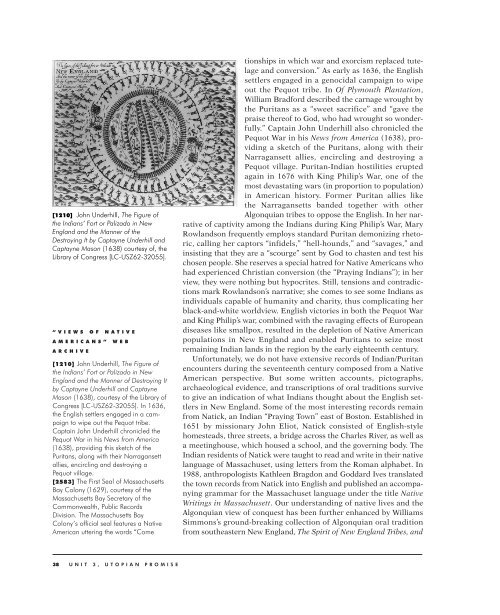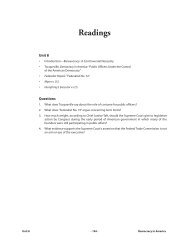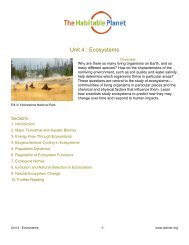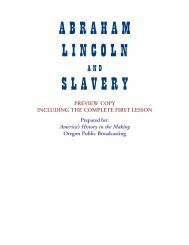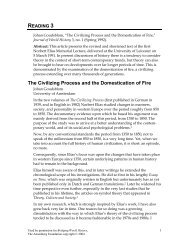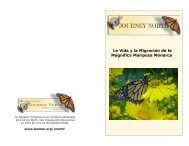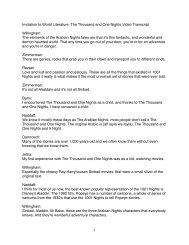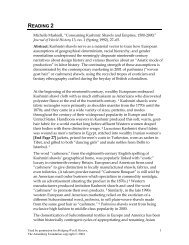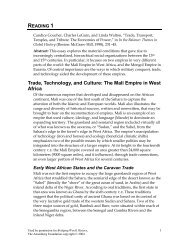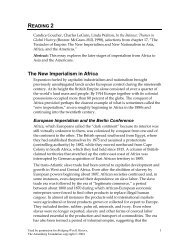UTOPIAN PROMISE - Annenberg Media
UTOPIAN PROMISE - Annenberg Media
UTOPIAN PROMISE - Annenberg Media
Create successful ePaper yourself
Turn your PDF publications into a flip-book with our unique Google optimized e-Paper software.
[1210] John Underhill, The Figure of<br />
the Indians’ Fort or Palizado in New<br />
England and the Manner of the<br />
Destroying It by Captayne Underhill and<br />
Captayne Mason (1638) courtesy of, the<br />
Library of Congress [LC-USZ62-32055].<br />
“VIEWS OF NATIVE<br />
AMERICANS” WEB<br />
ARCHIVE<br />
[1210] John Underhill, The Figure of<br />
the Indians’ Fort or Palizado in New<br />
England and the Manner of Destroying It<br />
by Captayne Underhill and Captayne<br />
Mason (1638), courtesy of the Library of<br />
Congress [LC-USZ62-32055]. In 1636,<br />
the English settlers engaged in a campaign<br />
to wipe out the Pequot tribe.<br />
Captain John Underhill chronicled the<br />
Pequot War in his News from America<br />
(1638), providing this sketch of the<br />
Puritans, along with their Narragansett<br />
allies, encircling and destroying a<br />
Pequot village.<br />
[2583] The First Seal of Massachusetts<br />
Bay Colony (1629), courtesy of the<br />
Massachusetts Bay Secretary of the<br />
Commonwealth, Public Records<br />
Division. The Massachusetts Bay<br />
Colony’s official seal features a Native<br />
American uttering the words “Come<br />
38 UNIT 3, <strong>UTOPIAN</strong> <strong>PROMISE</strong><br />
tionships in which war and exorcism replaced tutelage<br />
and conversion.” As early as 1636, the English<br />
settlers engaged in a genocidal campaign to wipe<br />
out the Pequot tribe. In Of Plymouth Plantation,<br />
William Bradford described the carnage wrought by<br />
the Puritans as a “sweet sacrifice” and “gave the<br />
praise thereof to God, who had wrought so wonderfully.”<br />
Captain John Underhill also chronicled the<br />
Pequot War in his News from America (1638), providing<br />
a sketch of the Puritans, along with their<br />
Narragansett allies, encircling and destroying a<br />
Pequot village. Puritan-Indian hostilities erupted<br />
again in 1676 with King Philip’s War, one of the<br />
most devastating wars (in proportion to population)<br />
in American history. Former Puritan allies like<br />
the Narragansetts banded together with other<br />
Algonquian tribes to oppose the English. In her narrative<br />
of captivity among the Indians during King Philip’s War, Mary<br />
Rowlandson frequently employs standard Puritan demonizing rhetoric,<br />
calling her captors “infidels,” “hell-hounds,” and “savages,” and<br />
insisting that they are a “scourge” sent by God to chasten and test his<br />
chosen people. She reserves a special hatred for Native Americans who<br />
had experienced Christian conversion (the “Praying Indians”); in her<br />
view, they were nothing but hypocrites. Still, tensions and contradictions<br />
mark Rowlandson’s narrative; she comes to see some Indians as<br />
individuals capable of humanity and charity, thus complicating her<br />
black-and-white worldview. English victories in both the Pequot War<br />
and King Philip’s war, combined with the ravaging effects of European<br />
diseases like smallpox, resulted in the depletion of Native American<br />
populations in New England and enabled Puritans to seize most<br />
remaining Indian lands in the region by the early eighteenth century.<br />
Unfortunately, we do not have extensive records of Indian/Puritan<br />
encounters during the seventeenth century composed from a Native<br />
American perspective. But some written accounts, pictographs,<br />
archaeological evidence, and transcriptions of oral traditions survive<br />
to give an indication of what Indians thought about the English settlers<br />
in New England. Some of the most interesting records remain<br />
from Natick, an Indian “Praying Town” east of Boston. Established in<br />
1651 by missionary John Eliot, Natick consisted of English-style<br />
homesteads, three streets, a bridge across the Charles River, as well as<br />
a meetinghouse, which housed a school, and the governing body. The<br />
Indian residents of Natick were taught to read and write in their native<br />
language of Massachuset, using letters from the Roman alphabet. In<br />
1988, anthropologists Kathleen Bragdon and Goddard Ives translated<br />
the town records from Natick into English and published an accompanying<br />
grammar for the Massachuset language under the title Native<br />
Writings in Massachusett. Our understanding of native lives and the<br />
Algonquian view of conquest has been further enhanced by Williams<br />
Simmons’s ground-breaking collection of Algonquian oral tradition<br />
from southeastern New England, The Spirit of New England Tribes, and


